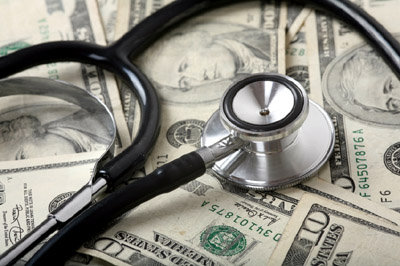Taxing Our Way to Good Health
 A bit over a year ago, Brad DeLong (who is a doctor but not a medical doctor) proposed “An Unrealistic, Impractical, Utopian Plan for Dealing with the Health Care Opportunity,” the crux of which is:
A bit over a year ago, Brad DeLong (who is a doctor but not a medical doctor) proposed “An Unrealistic, Impractical, Utopian Plan for Dealing with the Health Care Opportunity,” the crux of which is:
20% Deductible/Out of Pocket Cap: The IRS snarfs 20% of your family economic income. 5% of it is an increase in taxes (but that replaces your and your employer’s current health insurance premiums). 15% of it goes straight into your Health Savings Account. That HSA is then used to pay all your family health bills. If your expenses in a year are less than what’s in your HSA, the balance is rolled into your IRA (or, if you prefer, returned to you with your tax refund check).
Single-Payer for the Rest: If your HSA is emptied and you still have more health bills that year, the federal government pays them. The main point, after all, is insurance: if you fall seriously sick, you want right then and there to be treated whether or not your wallet biopsy is positive.
Sin Taxes: on Tobacco, Gorgonzola, Three-Liter Bottles of Liquid High-Fructose Corn Syrup, Tanning Clinics (Melanoma), et cetera: Sin taxes (and, perhaps, someday general revenues) pay for an army of barefoot doctors and nurses and mobile treatment vans roaming the country, knocking on doors, and providing preventive and other long-run lifestyle services for free: Let me examine your prostate. Mind if I check your refrigerator and tell you how to eat healthier? Have you exercised today? I’m a Pilates instructor, and we could do a session now? Are you up on your immunizations? Anybody here have a fever and need antibiotics? Come on out to the van and I’ll clean your teeth.” The idea is to make the preventive care cheaper-than-free, to insure that nothing with a high long-run benefit/cost ratio gets left undone because people would rather get a bigger check the next April to use to buy an HDTV.
A Lot of Serious Research on Best Public-Health, Chronic-Disease, and Hospital Practices: Made easier, of course, by linking the payment records from the health branch of the IRS to hospital records to the wirelessly-transfered logs from the barefoot doctor vans.
Matt Yglesias summarized it by adding two elements a month ago and E.D. Kain gives it his qualified endorsement this morning on the grounds that “adding health savings accounts (and thus direct, personal involvement) into the mix is a really good idea at containing costs.”
But the cost savings incentive would be rather marginal. There’s no concern at all for health care costs if Uncle Sugar is going to pay for any excess spending. That means the only personal incentive is the ability to take deferred savings and put it into one’s retirement account and draw upon it some decades hence. Given how little we save for own own retirement (beyond that which is forced upon us by FICA taxes) I’m unconvinced that’s a very powerful incentive.





As is common in such proposals the problem isn’t simply how high the tax is but how income is calculated.
Oh I don’t mean to out-of-hand endorse it (and I also qualified that some actual market moves might be more efficient than flat-out single-payer) but it was totally worth looking at especially since HSA’s have proven to be cost-saving. Also see this piece at The American. DeLong’s idea is basically the Singapore model, and here we have the AEI touting how great the Singapore model is…
Something to think about…
I think Americans have already either proven averse to or just plain bad at saving money. Forcing them to do it via the IRS is never going to happen.
Healthcare savings aren’t going to come from changing consumer behavior because by and large we don’t overindulge in medicine. Quite the opposite in fact we use far less preventative medicine than we should.
The savings come from removing the for profit aspect and redundant bureaucracies of a horde of insurance companies.
They’ve dropped the “from each according to his ability” to help sell the “to each according to his need.” But don’t worry, it will be back soon enough.
Why Gorgonzola? Is this part of a slippery slope that will lead to singling out other blue cheeses? Or is it rather the Roquefort lobby in action, attacking its mortal enemy? I’d like to know how much money this guy’s been paid by the French. This looks like Froggery to me, pure and simple.
Really? A family with a median income of $50,000 is on the hook for $10,000 (including the $2500 catastrophic-insurance tax). Uncle Sugar doesn’t start paying until that $10,000 is used up. That’s a lot of skin in the game.
Beyond that, it’s hard for me to see how individual consumers are ever going to bring market pressures to bear on providers of expensive, specialized treatment such as emergency surgery–expensive in excess of that $10,000 for a median income family–other than by not getting the condition treated at all.
I think if you make the HSA unspent amount return as a tax rebate (as proposed) then that gives a pretty strong incentive to not go “all you can eat” on the health care. At least for the nominal tax payer. But therein lies the problem. This is a huge change for our system. I suspect that overall, we would find ourselves paying much more for our healthcare as a society.
Why? Because the people who consume the largest amount of health care also have the lowest income, namely retirees. Fine, you take 20% of grandma’s social security check. She can then get any and all medical treatment she wants because uncle sugar is paying. It would be an a typical retiree who wouldn’t go through 20% of their income in health care costs.
Before people get too excited about the idea, lets see some numbers run. Take income by age and health care costs by age, and see what percentage with the status quo would be in the all you can eat sector. Then see what income and health care costs (including unpaid emergency room bills the hospital picks up) look like. I suspect that it would not prove to be any cost savings on its face.
There are also a lot more elements that would be needed. For example, tort reform, opening up the AMA stranglehold on the quantity doctors, open and upfront pricing, etc.
Stupid, waste of time.
Now, lets talk about my rich and fulfilling relationship with Jessica Biehl.
No it would be all cheeses, booze, cigars, candy, fatty foods of all kinds, any beverage that is bad for you, and so on. You’d be eating a government approved diet of grass, tree bark tea, and tofu. You’d likely have a very healthy horrifingly boring and thoroughly tasteless meal…probably the same meal three times a day. You’d be weighed, poked, pinched and checked over constantly for anything that might be wrong. In other words, a huge and massive expansion of the Nanny State.
Hell, they’d probably be monitoring when you had sex, for how long, and who you’re partners are with. In DeLong’s world there would be a nurse there (suitably unattractive…no spontaneous threesomes) to make sure you’ve put the condom on right.
That people are even remotely giving this any kind of serious thought is just….
Uhhhmmm no. The Singapore model does not have that nanny stating thing going on in regards to health care. Did you see this part,
By the way, this ain’t cheap. In fact, its quite expensive. Any cost savings would be minimal and possible none at all. The old canard of an ounce of prevention is worth a pound of cure is not true once you involve health care professionals, at least that was what the CBO and other research indicates.
Steve – there’s a lot I don’t like about the proposal. I like the idea of HSA’s a lot though. And actually Singapore has quite a lot of government involvement – even Nanny Statism – in their system. They just still manage to keep the costs low. From the American article:
That’s not bad, but there sure are a lot “public” options available.
“Quite the opposite in fact we use far less preventative medicine than we should.â€
It is true that some would save money with preventive measures but as a group it is not true. The so call free (taxpayer paid) healthcare would result in a great increase in preventive test. A very small percent would save money on preventing an illness but the majority would not, resulting in an overall much greater medical expense for the society and exhaustion of medical resources, resulting in much lower quality of care.
Preventive test is a good idea when done right. However when many in society perceive it as “free†when in reality it is not, they tend to abuse the system similar to what happens in emergency ward now. That would result in a breakdown of the system and we would end up with a dysfunctional healthcare.
Me thinks you have the conspiracy backwards, Michael (August 21, 2009 | 11:04 am):
It is an attempt by this blog to make the French irrelevant by ignoring the fine selection of French cheeses. Consider that the most recent caption contest on this blog had an Australian naval vessel pointing its gun at the Statue of Liberty, a gift by the French to the American people. Or that the American delicacy cooked in fat and laden with salt now termed Freedom Fries.
The more the French disappear, the less we have to contemplate a health care system that is superior to ours. I am a bit worried about the Swedes taking their place.
By the way James, my pappy once told me that best way to waste time is by reinventing a better wheel. The most frugal and best health care outcomes are from countries with government sponsored single payer systems. Said it before, but I will say it again. Data speaks for itself, and ideology impedes examination of problems.
On second thought you may be right Michael. The French may be striking back through our weak under-belly, Hollywood. A recent propaganda film with two traitorous American actresses depicted the joy of French cooking, and in a snippet impugned the reputation of that great American Patriot, Senator Joseph McCarthy. A truly dastardly bunch…
Sure it does. Aside from the hospital networks mentioned by E.D. Kain, the Singaporean model is almost exactly the same as DeLong’s model, including
A)mandatory contributions to the equivalent of an HSA, and
B)universal government-provided catastrophic coverage for everything else.
The only difference is the “health vans” proposed by DeLong, and the exact amounts demanded in tax contributions.
The major change I would make would be to specify what exactly is covered under the government-catastrophic plan, and then if you go over on the stuff that’s supposed to be covered by your money in the HSA, the government pays – but it gets deducted from what you get back as a tax return for next year’s HSA rollover.
Or-
If you specified what’s covered by the universal catastrophic plan, you could sell supplementary insurance policies that you could use in addition to your HSA if you ended up accidently going over. They’d pay for the equivalent of additional primary care and possibly some other services.
“but it was totally worth looking at especially since HSA’s have proven to be cost-saving.”
I have looked for data on this and I have not seen anything conclusive as there is so much selection bias. What study were you thinking about. Even the recent study by the actuaries had selection bias, but it was good enough to merit a real trial IMO.
“Uhhhmmm no. The Singapore model does not have that nanny stating thing going on in regards to health care. Did you see this part,”
Did you read the whole AEI article? They require a mandatory 20% of income pension contribution by the individual and 13% by the employer. This goes into a government run pension IIRC (too lazy to go find again). There is a public option for insurance or you can buy from a private company. They have a VAT of 7% and top tax rates of 20%. Now, who wants to call Nordquist and tell him that a 33% mandatory pension contribution is not really a tax? I can see why Yglesias likes it, but conservatives?
Steve
Well, something has to change. Recently turned 50, so I had a colonoscopy. 12k for a routine 45 minute procedure. 4 people in the room. WTF?
Then they “write off” 7k. So in other words, they are overcharging by 7k, but they have a lot of wiggle room on the margin. No wonder the CEO of Blue Cross makes 57 million a year…
These suggestions are utterly impractical, not to mention possibly useless in improving the state of health care.
For starters, cost savings are achieved by spreading risk. This means that healthy people subsidize unhealthy people in order to have the same benefits if one should suddenly become unhealthy. HSAs, to my understanding, do not do that. The government eats the excess costs of those who are unhealthy, but those who are healthy do not have to contribute any subsidies. I don’t see how cost savings can arise from that.
On the surface, this may seem to be an incentive for people to alter their behaviour. True, if people are aware of complex schemes such as this. Most will see 20% of their paycheck deducted and won’t realize what benefits they will receive. Also, even if people are aware, there is incredible inertia in altering behaviour. I assume that most people are aware that being overweight is unhealthy, and that most people would prefer to lose weight, but the obesity rate continues to go up.
Sin taxes are generally a good idea, but using the proceeds to pay for prevention might not be so useful. I have already mentioned the inertia in changing lifestyles. If the ground team cannot convince people to be more healthy, all they can do is screen and try to identify conditions earlier. This will actually add to the cost of health care (for admittedly possibly better outcomes). Think of it this way: Say 1/100 develop some kind of heart disease that costs $10000 to treat if detected after 1 year and $1000 if within 1 year. Also assume that patients will go to the hospital with acute symptoms after 1 year (free) but will need professional screening ($100 cost) to detect if within 1 year. The cost of waiting to see which of the 100 develops the heart disease and then treating is just $10000. If we screen each person every half year, we will spend $11000 for combined screening and treatment.
The bottom line is that screening for all but the most common conditions (or unless the process is cheap) is impractical. Take it from someone in the health care industry, “watchful waiting” is often the most effective (from an outcome pov) and the cheapest.
I have the solution: Let us do away with “health insurance” altogether. That way “personal responsiblity” really is personal (and pertinent).